#Friedrich-Becker-Preis
Explore tagged Tumblr posts
Text
Führungswechsel in Hanau: Malte Gutteck
Der Kunsthistoriker Malte Guttek übernahm Anfang 2024 in Personalunion die Geschäftsführung der Gesellschaft für Goldschmiedekunst e.V. sowie die Leitung des Deutschen Goldschmiedehauses Hanau von Christianne Weber-Stöber. Auch sie folgte vor 34 Jahren als junge Kunsthistorikerin dem Angebot als Geschäftsführerin der Gesellschaft für Goldschmiedekunst tätig zu werden. Angesiedelt war diese damals…
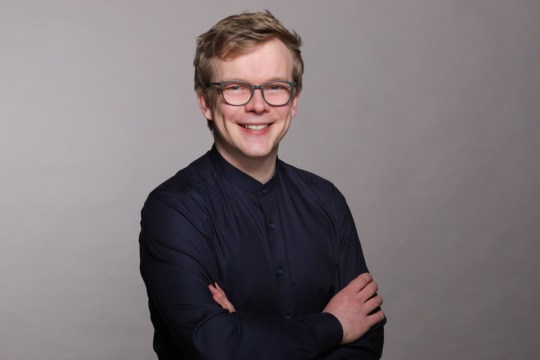
View On WordPress
#angewandte Kunst#Celia Holzer Stipendium#Christianne Weber-Stöber#Deutsches Goldschmiedehaus#Friedrich Becker Preis#Gesellschaft für Goldschmiedekunst e. V.#Goldene Medaille#Goldener Ehrenring für Künstler#Hanau#Handwerkskunst#Innovation#Inspiration#Köln#Kolumba#Konzept#Kunst#Kunsthandwerk#Malte Guttek#Museumsleitug#Schmuck#Silbertreinnale International#Staatliche Zeichenakademie Hanau#Stadt Hanau#Struktur
0 notes
Text
Fear and peace, strings of death tied to life.
“Culture absolutely cannot do without passions, vices, and acts of malice.” – Friedrich Nietzsche, Human, All Too Human
No matter the answer to the question of peace, it is no less a horrifying structure than the wars it acts as the violent precursor to. Peace has, throughout history, mostly been exemplified by its duality; in the aftermath of conflict, it is equally punishment and recompense as it is an achievement and blessing. For it to exist as a monolithic force permitting the temporary absence of that conflict, one side had to be “victorious” while the other was “defeated.”
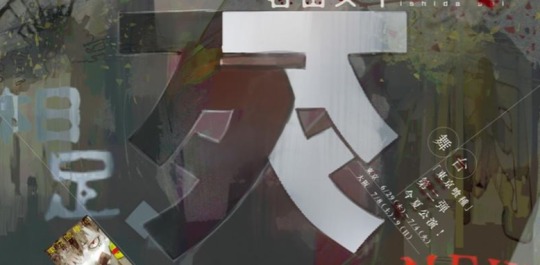
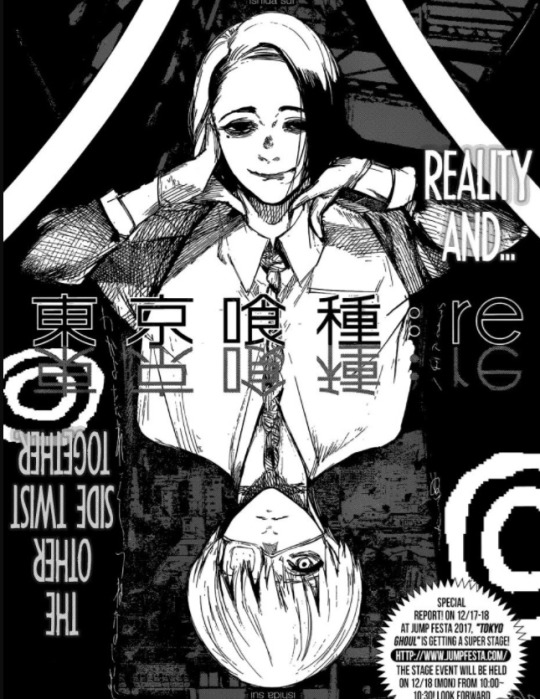
The Oggai are expensive tools in Furuta’s zero-sum game, embodying loss and gain of personal and societal identities. The kanji is half of “death” reflected upon itself, alluding to the children who were stripped of humanity and went on to exceed the basic human condition, whose collective function is to rain death upon ghouls and humans alike. Compromise cannot stand when evil and good, black and white are polarized to the point of comedy. Furuta’s vision for peace flares with passionate indifference to the end of life, the end of the inferior masses to assemble invulnerable, chaotic instruments that can conquer and succeed in their place. Dying alone is a bore, too easy, too frightening an act, so he chooses life with a noose around his neck; the psychology of a deranged, depraved man lies in his need to frantically grab on to every bit of what little he can precisely because it has failed to hold meaning for him any longer. His focus veers toward what he should have been once he has lost good sense of what he should be, and he is crippled completely by his fear of moving anywhere at all after even that necessity has disgraced him and vanished. “Peace” and “ethics” thus become simple words to lob around for a taste at trivial triumph. Only by his own lack of meaning for such can he blindly demand them from others, stoke the flames of his fraudulent ambitions, be exalted as a profane god.
But a god that sins and shits no differently than their venal worshipers is no god, else they are all gods. These souls together convulse in agony, joined by the primal fear of death, of the death of their wants and needs. What sets the pretenders apart is their unvarnished audacity in exploiting that fear in those they deem weaker than themselves, until they collapse and become the exploited.
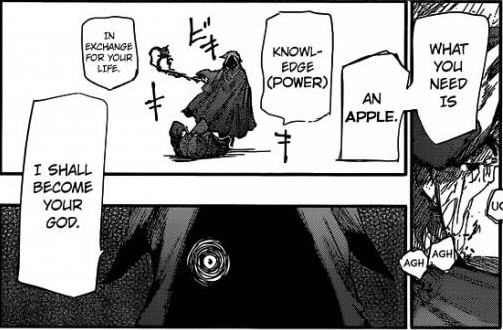
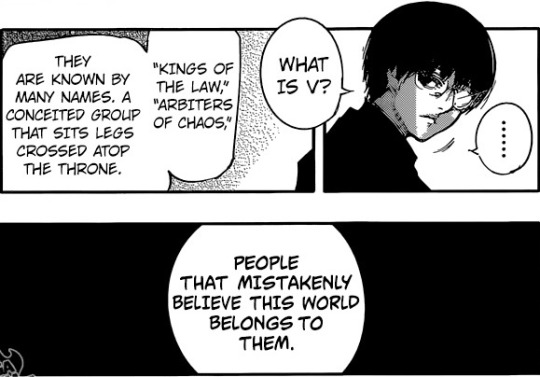
“I want to take this fucked up, piece of shit world, fuck it up even more, and give it a factory reset.” (TG:re, ch. 86)
Each god rises from the ashes of the one before, endowed with a hereditary love of destruction and no more than that. To say that they are frivolous hypocrites isn’t a totally exaggerated assumption. Like Furuta, Eto was embittered in her fundamental loneliness, filled with revulsion for the father that she could not freely call her own. Her vengeance against the world for allowing her birth was a revolution for egoistic peace, and with the conviction that her methods would help dissolve the twisted birdcage came a pitifully inflated complex that rivaled V’s. She regarded V with the most livid contempt for their “mistaken belief” yet emerged guilty of exactly that — she would wrest the fucked up world from their vile, corpse-befouled hands with her own vile, corpse-befouled hands, a rejection of their peace for hers.
Unrepentant reapers like Furuta, Eto, and V/the Washuu can be readily epitomized by a singular line from Ernest Becker’s The Denial of Death, that hatred and chaos are baneful effects of the pathetic struggle against the fragile self afraid of death in its ultimate form:
“If we don’t have the omnipotence of gods, we at least can destroy like gods.”
Suppose that they or anyone else had their way. What follows once they have “reset” the world? Perhaps a rhythmic balance between life and death would be the prelude to this elusive peace if it could be contained, but life is death in progress, and the story is framed around characters who are thrust daily into the fetid maw of decay, killing and getting killed as they defend their right to life more than they can ever leisurely exercise it.


Juuzou voices his uncertainty and the scene exudes a palpable desolation as the paper plane is carried away in the wind to a destination unknown amidst the vastness before them. He admits he doesn’t know what peace really is, and then wonders if they’ll ever have it. How will one begin to realize or even appreciate that they have attained something worthwhile if they cannot recognize it? Further, if its meaning and existence are lost on its bearers, is there any point to its presence?
Peace is the paper plane — it can be thought of as a product of pernicious inertia, supplying its makers with a momentary calm until it must be let go. It’s both a loyal preservation and betrayal of a utopian ideal. A transition into the next essential war. Human beings inherently pursue the science of search, toiling tirelessly to invent, to claim their discoveries or distribute them for a profit. When the world is well it becomes lethargic; the monotony of that wellness sets in and weariness begins to stir anew.

The mood between Juuzou’s and Hakatori’s dialogues proffers the notion that peace is also a myth conjured by those fortunate enough to survive because they’re slavering for a conscious goal, a reason to justify the ceaseless bloodshed. If all humans were to be erased, then the ghouls’ natural source of sustenance disappears, leaving them to resort to permanent cannibalism. Without external energy being introduced into the food chain it is rendered obsolete, and they would regress as a species until they are extinct. Contrarily, a picture of the human world should all ghouls be erased would be a remarkably tedious echo of our own — political and social warfare, hate and ideological segregation would nevertheless continue to spin the wheel of violence that could never be buried.
Although Juuzou cannot explain the logic to his doubt, he does know that he prefers the status quo since there is little room for stability in either case. This is cemented by Hakatori’s (Tatara’s) statement that the innate curiosity for courses uncharted precipitates devastation. It is also a thinly veiled way of hinting at the perversion of peace as demonstrated by the Oggai, a unified symbol of peace in pieces, bloodhounds with an extraordinary capacity for sniffing out their prey and tearing them to shreds. Could their peace be the honest one if they have to flatten that of their allies and their enemies indiscriminately to reach it?

It isn’t, and it isn’t real. In their universe and this one, it’s the willful fabrication of those who have accepted that the world has unfailingly been ravaged and reinforced by war and peace in tandem, that while discovery inextricably leads to war, they are doomed to honor the duty of upholding that cycle as surely as they are wired to seek evolution. The remaining participants in the great stage play that is the riven world, like Naki and Ui, illustrate the insidious nature of the anxiety of death, why it so often extends to the people they love that they could implore life of the very gods that snatched it away.
In a series alight with the colors of tragedy, the sacrifice of life does well to encapsulate the illusory charm and unmitigated fear of a lasting peace. In this the ghouls and humans are one and the same. There are no gods or demons or monsters, just people steeped in varying shades of torment. They will strive and endure, strive to endure, but never be able to break the final barrier that would enable them to cast away the human essence. The sentimentality in fighting for what is false is their only truth, an incurable sickness shared among the living in search of an escape from the ennui that surreptitiously nourishes and devours them all.
#tokyo ghoul:re#tokyo ghoul re#tg:re#tg meta#furuta nimura#eto#yoshimura eto#I think this became less theory and analysis#and more sinking into the futility of this whole shitshow#meta: mine
133 notes
·
View notes
Text
Friedrich Becker Preis 2023: Düsseldorf vom 06. bis 30.05.2023
Mit der Vergabe des mit 10.000 Euro dotierten Friedrich Becker Preises Düsseldorf, einer Stiftung von Hildegard Becker (1928–2018), erinnert die Gesellschaft für Goldschmiedekunst e. V. seit 1999 an den herausragenden Goldschmied, Professor Friedrich Becker (1922–1997). Als international bekannter Gestalter kinetischer Objekte und Designer im Umkreis der Düsseldorfer Kunstszene wurde Becker…

View On WordPress
#analog#angewandte Kunst#digital#Friedrich Becker Preis 2023#Goldschmiedehaus Hanau#Jury#Kunsthandwerk#Norman weber#Schmuck#Schmuckgestaltung#Stadtmuseum Düsseldorf#Unikatschmuck
1 note
·
View note
Text
Nachfolge gesucht: Hanau - Bewerbungsfrist 15.02.2023
Eine Zeitenwende steht bevor! Die gemeinnützige, international agierende Gesellschaft für Goldschmiedekunst e.V. ist das Netzwerk jener, die sich der Gestaltung und Vermittlung von Schmuck und Gerät verschrieben haben. Die Ausrichtung internationaler Wettbewerbe liegt ebenso in ihrer Verantwortung wie die Leitung des Deutschen Goldschmiedehauses Hanau, eines der wichtigsten Ausstellungszentren…

View On WordPress
#Deutsches Goldschmiedehaus Hanau#Dr. Christianne Weber-Stöber#Friedrich-Becker-Preis#Geschäftsführung#Gesellschaft für Goldschmiedekunst#Inhorgenta München#international#Kurator#Mitglieder Künstler#MuseumPlus#Museumspädagogoik#Nachfolge#Rhein-Main-Region#Sammlungsmanagement#Schmuck#Schmuckkunst#Silbertriennale#Stadt Hanau#Wettbewerbe
0 notes
Text
Ausschreibung Friedrich Becker Preis 2023: Bewerbung bis 10.02.2023
Ausschreibung Friedrich Becker Preis 2023: Bewerbung bis 10.02.2023
Professor Friedrich Becker (1922–1997) gehört zu den herausragenden Künstlerpersönlichkeiten unserer Zeit. Als international bekannter Goldschmied, als Gestalter kinetischer Objekte und Designer im Umkreis der Düsseldorfer Kunstszene wurde er prägend für die Goldschmiedekunst der zweiten Hälfte des 20. Jahrhunderts. Für seine Werke erhielt er weltweit erste Preise und höchste Anerkennungen.…

View On WordPress
#Dr. Olaf Thormann#Dr. Sabine Runde#Friedrich Becker Preis 2023#Gerät#Gerätgestaltung#Gesellschaft für Goldschmiedekunst#Goldschmied#Goldschmiedehaus Hanau#Hanau#kinetische Objekte#Preisverleihung#Professor Friedrich Becker#Prototyp#Schmuck#Schmuckgestaltung#Schnuppe von Gwinner#Silvia Weidenbach#Stadtmuseum Düsseldorf#Teilnahmebedingungen#Unikat
0 notes
Text
Friedrich Becker Preis Verleihung 2020
Friedrich Becker Preis Verleihung 2020
Mit der Vergabe des Friedrich Becker Preises, gestiftet von Hildegard Becker, will die Gesellschaft für Goldschmiedekunst Hanauan den besonderen Menschen und großen Gestalter Friedrich Becker erinnern und ganz in seinem Sinne die Besten einer nachfolgenden Gestaltergeneration auszeichnen. Der Friedrich Becker Preis ist mit 10.000 Euro dotiert und wird seit 1999 alle drei Jahre von der…
View On WordPress
#Andrea Wippermann#Cornelie Holzach#Friedrich Becker Preis 2020#Gesellschaft für Goldschmiedekunst Hanau#Goldschmied#Goldschmiedekunst#Hildegard Becker#Hochschule Wismar#kinetische Objekte#Professor Friedrich Becker#Sam Tho Duong#Schmuckmuseum Pforzheim
0 notes
Text
Ausschreibung Friedrich Becker Preis 2020: Bewerbungsschluss 14.02.2020
Professor Friedrich Becker(1922–1997) gehörte zu den herausragenden Künstlerpersönlichkeiten unserer Zeit. Als international bekannter Goldschmied, als Gestalter kinetischer Objekte und Designer im Umkreis der Düsseldorfer Kunstszene wurde er prägend für die Goldschmiedekunst der zweiten Hälfte des zwanzigsten Jahrhunderts. Für seine Werke erhielt er weltweit erste Preise und höchste…
View On WordPress
#Alexander Vohswinkel#Anette Walz#Cornelie Holzach#Friedrich Becker Preis#Goldschmiede#Jury#Kinetik#kinetischer Schmuck#Michael Becker#Peter Bauhuis#Prof. Andrea Wippermann#Robert Baines#Rudolf Bott#Sam Tho Duong#Schmuck#Schmuckgestaltung#Schmuckkunst#Schmuckschaffen#Silberschmiede
0 notes
Text
Friedrich Becker Preis 2017: Düsseldorf vom 04. bis 30.03.2017
Friedrich Becker Preis 2017: Düsseldorf vom 04. bis 30.03.2017
Im Düsseldorfer Stadtmuseum wurde der Münchner Goldschmied Michael Becker am 4. März 2017 mit dem Friedrich Becker Preis, dotiert mit 5.000 €, ausgezeichnet. Mit diesem Preis der privaten Stiftung von Hildegard Becker in Düsseldorf, erinnert die Gesellschaft für Goldschmiedekunst e.V. seit 1999 alle drei Jahre an den herausragenden Goldschmied und Gestalter kinetischer Objekte Professor Friedrich…
View On WordPress
#Alexander Vohswinkel#Anette Walz#Autorenschmuck#Beate Leonards#Bettina Speckner#Düsseldorfer Stadtmuseum#Friedrich Becker Preis#Gesellschaft für Goldschmiedekunst e.V.#Gold#Jiro Kamata#Lapislazuli#Lifestyle#Michael Becker#Pavel Opocensky#Peter Bauhuis#philip Sajet#Prof. Peter Skubic#Robert Baines#Rudolf Bott#Sam Tho Duong#Schmuck#Silber#Svenja John#Vivi touloumidi
0 notes